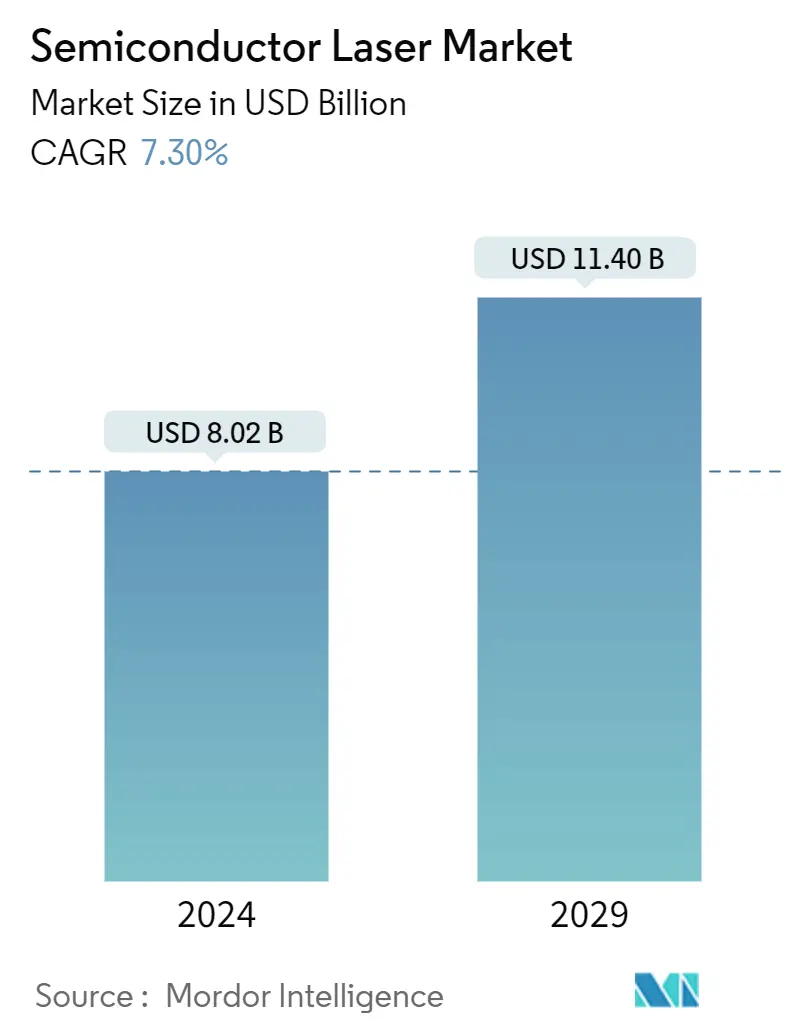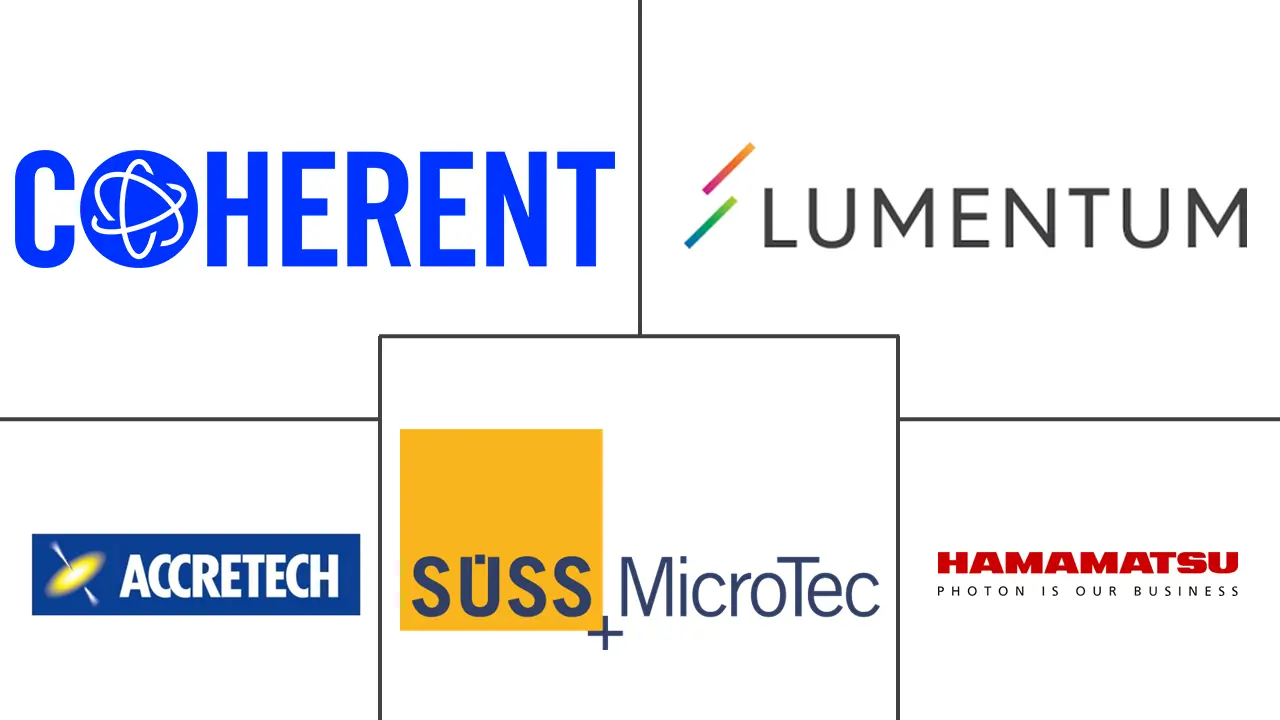Market Size of Semiconductor Laser Industry

| Study Period | 2019 - 2029 |
| Market Size (2024) | USD 8.02 Billion |
| Market Size (2029) | USD 11.40 Billion |
| CAGR (2024 - 2029) | 7.30 % |
| Fastest Growing Market | Asia-Pacific |
| Largest Market | North America |
Major Players*Disclaimer: Major Players sorted in no particular order |
Semiconductor Laser Market Analysis
The Semiconductor Laser Market size is estimated at USD 8.02 billion in 2024, and is expected to reach USD 11.40 billion by 2029, growing at a CAGR of 7.30% during the forecast period (2024-2029).
- Lasers are attaining significant traction in the semiconductor industry as they present flexible, developed machining to fulfill the stringent needs of the industry, delivering semiconductor manufacturers with an exact method of cutting complex shapes from different materials with high precision. A laser system custom-developed for semiconductor applications can cut a range of materials accurately and fast.
- The semiconductor market is witnessing several innovations owing to robust R&D activities. For instance, in November 2022, researchers from the LP3 Laboratory in France developed a direct laser writing technique to achieve local material processing within the 3D space of semiconductor chips. They claim that the dominating manufacturing technology, lithography, has significant limitations in thoroughly addressing the challenges posed by the semiconductor manufacturing sector. For this reason, fabricating structures under the wafer surfaces would be highly desirable to use the whole space inside the materials. In the International Journal of Extreme Manufacturing, the researchers demonstrated such capability via the newly designed direct laser writing technique, which facilitates fabricating implanted structures inside different semiconductor materials.
- Further, in June 2022, engineers at the University of California, Berkeley (Department of Electrical Engineering and Computer Sciences (EECS)) designed a new type of semiconductor laser that completes an elusive goal in the field of optics: the ability to sustain a single mode of emitted light while retaining the ability to scale up in size and power. It is a significant achievement as it means size does not have to come at the cost of coherence, allowing lasers to become more powerful and cover longer distances for many applications.
- The studied market is noticing an increase in demand due to numerous initiatives by governments of various nations. For instance, the United States government aims to become independent in the semiconductor supply chain ecosystem. To realize such goals, the United States government has started taking initiatives. Such as the US government recently introduced Investing in Domestic Semiconductor Manufacturing Act in the Senate. This proposed legislation would expand eligibility for CHIPS for America, a government subsidy program for the semiconductor industry, to fund financial assistance beyond entities involved in semiconductor fabrication, testing, assembly, or R&D to organizations involved with materials used to manufacture semiconductors and semiconductor manufacturing equipment. By incentivizing the companies that produce essential materials and equipment, this legislation can create more opportunities for manufacturers nationwide and strengthen the supply chain supporting domestic semiconductor manufacturing.
- Additionally, in September 2022, the Biden administration announced that it would invest USD 50 billion in building up the domestic semiconductor industry to counter dependency on China, as the US produces zero and consumes 25% of the world's leading-edge chips vital for its national security. President Joe Biden signed a USD 280 billion CHIPS bill in August 2022 to boost domestic high-tech manufacturing, part of his administration's push to increase US competitiveness over China. Such robust investments in the semiconductor sector in the region would create lucrative opportunities for the growth of the studied market.
- However, on the Flipside, the initial calibration of lasers is a very complex task and requires a high level of expertise to achieve the high-precision tuning needed for the application. Also, the vast number of parameters has to be considered while tuning the laser, and a small offset may lead to errors or be catastrophic in various applications. The manufacturing process of the lasers is very complex, due to which the manufacturing cost has also increased significantly. Another important aspect of the laser's performance when switching between wavelengths is the stability of the wavelength of the device. As the laser tunes into its desired wavelength, settling drift appears before the channel finally stabilizes. Such factors might hinder the growth of the studied market.
- Furthermore, semiconductor manufacturing is a costly and time-consuming process and requires cutthroat precision in all the equipment/processes involved. As a result, industry expansion is limited in economically less developed regions. Lasers, being one of the integral components of the semiconductor industry, also face similar challenges that slow down the studied market's growth.
Semiconductor Laser Industry Segmentation
A laser is a device or source that stimulates atoms or molecules to emit light at particular wavelengths and amplifies that light, typically producing a very narrow beam of radiation. Lasers are widely used in the semiconductor industry for various applications, including drawing the pattern of the chip, inspection, etc.
The Semiconductor Laser Market is segmented by wavelength (infrared lasers, red lasers, green lasers, blue lasers, ultraviolet lasers), by type (EEL (Edge-emitting Laser), VCSEL (Vertical-cavity Surface-emitting Laser), quantum cascade laser, fiber laser, other types), by application (communication, medical, military and defense, industrial, instrumentation and sensor, automotive, other applications), by geography (North America, Europe, Asia Pacific, Latin America, Middle East and Africa). The market sizes and forecasts are provided in terms of value (USD) for all the above segments.
| By Wavelength | |
| Infrared Lasers | |
| Red Lasers | |
| Green Lasers | |
| Blue lasers | |
| Ultraviolet Lasers |
| By Type | |
| EEL (Edge-emitting Laser) | |
| VCSEL (Vertical-cavity Surface-emitting Laser) | |
| Quantum Cascade Laser | |
| Fiber Laser | |
| Other Types |
| By Application | |
| Communication | |
| Medical | |
| Military and Defense | |
| Industrial | |
| Instrumentation and Sensor | |
| Automotive | |
| Other Applications |
| By Geography | |
| North America | |
| Europe | |
| Asia-Pacific | |
| Latin America | |
| Middle East and Africa |
Semiconductor Laser Market Size Summary
The semiconductor laser market is poised for significant growth, driven by advancements in laser technology and increasing demand across various sectors. Lasers are becoming integral in the semiconductor industry due to their ability to provide precise and flexible machining solutions, essential for cutting complex shapes from diverse materials. Innovations such as direct laser writing techniques and new semiconductor laser designs are pushing the boundaries of what is possible in semiconductor manufacturing, addressing limitations of traditional methods like lithography. The market is further bolstered by government initiatives, particularly in the United States, aimed at strengthening domestic semiconductor supply chains, which include substantial investments and legislative support to enhance manufacturing capabilities and reduce dependency on foreign sources.
The Asia-Pacific region plays a crucial role in the semiconductor laser market, with significant investments and government policies supporting the industry's growth. Countries like China, South Korea, and Taiwan are leading in semiconductor equipment spending, which directly benefits the laser market. Additionally, initiatives in India and Japan are expected to drive further expansion. The increasing adoption of consumer electronics, automotive applications, and IoT devices in this region is creating a favorable environment for market growth. Despite challenges such as the complexity and cost of laser manufacturing, the market remains competitive, with key players like Lumentum Operations and Coherent Inc. continuously innovating to meet the evolving demands of the semiconductor industry.
Semiconductor Laser Market Size - Table of Contents
-
1. MARKET INSIGHTS
-
1.1 Market Overview
-
1.2 Industry Value Chain Analysis
-
1.3 Industry Attractiveness - Porter's Five Forces Analysis
-
1.3.1 Bargaining Power of Suppliers
-
1.3.2 Bargaining Power of Buyers/Consumers
-
1.3.3 Threat of New Entrants
-
1.3.4 Threat of Substitutes Products
-
1.3.5 Intensity of Competitive Rivalry
-
-
1.4 Impact of COVID-19 and Other Macroeconomic Factors on the Market
-
1.5 Tech Snapshot
-
-
2. MARKET SEGMENTATION
-
2.1 By Wavelength
-
2.1.1 Infrared Lasers
-
2.1.2 Red Lasers
-
2.1.3 Green Lasers
-
2.1.4 Blue lasers
-
2.1.5 Ultraviolet Lasers
-
-
2.2 By Type
-
2.2.1 EEL (Edge-emitting Laser)
-
2.2.2 VCSEL (Vertical-cavity Surface-emitting Laser)
-
2.2.3 Quantum Cascade Laser
-
2.2.4 Fiber Laser
-
2.2.5 Other Types
-
-
2.3 By Application
-
2.3.1 Communication
-
2.3.2 Medical
-
2.3.3 Military and Defense
-
2.3.4 Industrial
-
2.3.5 Instrumentation and Sensor
-
2.3.6 Automotive
-
2.3.7 Other Applications
-
-
2.4 By Geography
-
2.4.1 North America
-
2.4.2 Europe
-
2.4.3 Asia-Pacific
-
2.4.4 Latin America
-
2.4.5 Middle East and Africa
-
-
Semiconductor Laser Market Size FAQs
How big is the Laser Market for Semiconductor Industry?
The Laser Market for Semiconductor Industry size is expected to reach USD 8.02 billion in 2024 and grow at a CAGR of 7.30% to reach USD 11.40 billion by 2029.
What is the current Laser Market for Semiconductor Industry size?
In 2024, the Laser Market for Semiconductor Industry size is expected to reach USD 8.02 billion.


